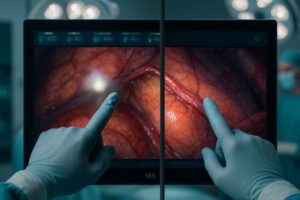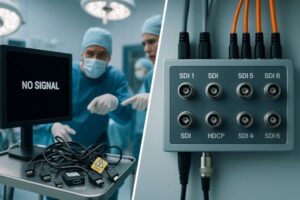Signal dropouts during critical procedures are unacceptable. This instability compromises 4K image quality, but choosing the right interface ensures a reliable, crystal-clear video feed when it matters most.
DisplayPort 1.2+ is often preferred for its high bandwidth and robust connection, ideal for diagnostic imaging. However, 12G-SDI is the top choice for long-distance, stable transmission in integrated operating rooms, while HDMI 2.0 remains a common, accessible option for shorter connections.
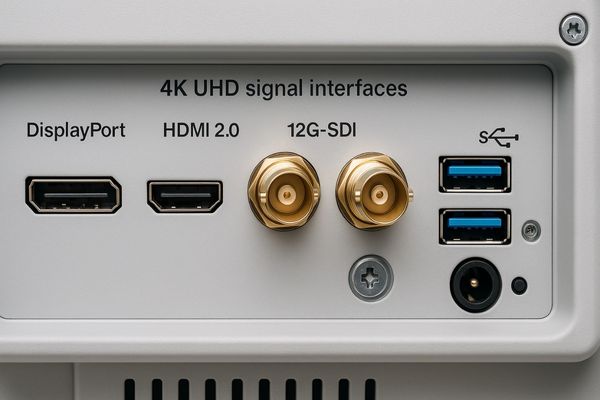
I have worked with all these interfaces in various clinical settings. Each has specific strengths and weaknesses that can significantly impact system performance. The choice is not just about connecting a cable. It is about guaranteeing signal integrity1 from the image source to the screen. A stable, high-fidelity connection is the foundation of modern medical imaging2. Without it, the benefits of a 4K display3 are lost. In this article, I will explain the key differences between these interfaces. This will help you select the best one for your 4K UHD needs.
Why is DisplayPort often favored over HDMI in medical imaging?
An unstable connection can flicker or drop, causing diagnostic uncertainty. While HDMI is common, DisplayPort’s locking mechanism and higher bandwidth offer superior reliability for detailed medical images.
DisplayPort is favored over HDMI in medical imaging due to its higher bandwidth capabilities, locking connector that prevents accidental disconnection, and inherent support for daisy-chaining multiple monitors. This makes it a more robust and professional choice for high-resolution diagnostic workstations.
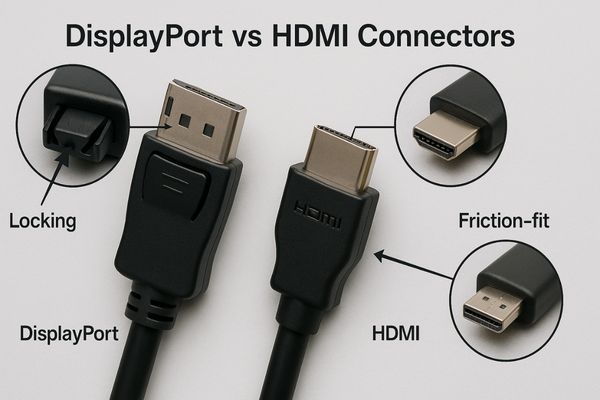
In a professional environment like a radiology reading room, signal reliability is paramount. DisplayPort4 (DP) was designed from the ground up for high-performance computer displays, and it has several advantages over the more consumer-focused HDMI standard. First, most DisplayPort connectors include a physical locking mechanism. This small feature is incredibly important in a clinical setting, as it prevents the cable from being accidentally pulled out, which would interrupt a diagnostic review. Second, DP generally offers more bandwidth. DisplayPort 1.2, a common standard, supports 4K at 60Hz5 and has been a staple for years. Later versions like DP 1.4 offer even more headroom for higher resolutions and refresh rates. This bandwidth is delivered via a packet-based data structure, which is more flexible than HDMI’s TMDS system. This allows for features like Multi-Stream Transport (MST)6, which lets a user connect multiple monitors in a "daisy-chain" from a single DP port on the source device. For multi-screen setups like our MD120C 12MP monitor, this simplifies cabling and improves workflow efficiency.
DisplayPort vs. HDMI: Key Differences
| Feature | DisplayPort | HDMI |
|---|---|---|
| Connector | Physical locking mechanism | Friction-fit, can disconnect easily |
| Primary Use | Computer & Professional Displays | Consumer Electronics (TVs, Consoles) |
| Multi-Monitor | Supports daisy-chaining (MST) | Requires separate port for each monitor |
| Data Structure | Packet-based (more flexible) | TMDS (fixed bandwidth channels) |
How does SDI compare to HDMI in terms of stability and distance?
Running long video cables often degrades the signal, causing a blurry or lost picture. HDMI fails over distance, but SDI is specifically designed for long, stable transmission in professional environments.
SDI (Serial Digital Interface) offers far greater stability and transmission distance than HDMI. A single SDI cable can reliably carry a 4K signal over 100 meters, while HDMI quality degrades significantly after 15 meters, making SDI superior for large or integrated operating rooms.
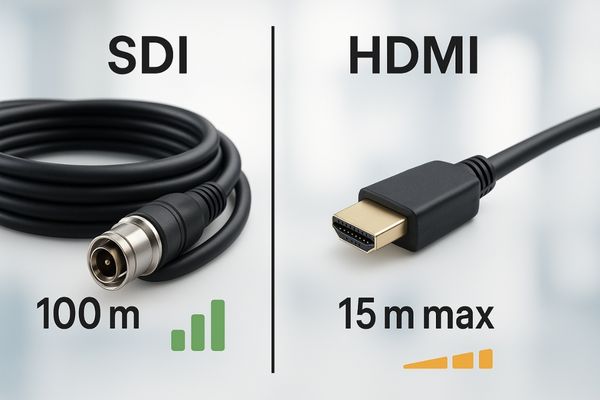
SDI is the workhorse of the broadcast and professional video industries, and for good reason. It is built for absolute reliability over long distances. SDI7 uses coaxial cable with BNC connectors, which are a type of locking connector that twists and secures into place. This robust physical connection prevents accidental signal loss. The primary advantage, however, is distance. A high-quality HDMI 2.0 cable starts to lose signal integrity beyond 15 meters, requiring expensive boosters or extenders. In contrast, a single 12G-SDI8 cable can carry a 4K 60Hz signal up to 100 meters without any degradation. This is essential in an integrated operating room where the surgical display9 may be on a boom far from the video source in a control room or equipment rack. This long-reach capability simplifies installation and eliminates potential points of failure associated with signal repeaters. For large-format displays like the MS550P 55" surgical monitor, which is often positioned at the center of a complex OR, SDI provides the stable, long-distance connection needed to ensure the surgical team always has a clear and uninterrupted view.
Is a single cable enough for 4K@60Hz transmission?
Juggling multiple cables for one display creates clutter and adds points of failure. This complexity is unnecessary, as modern single-cable solutions can deliver full 4K@60Hz video without compromise.
Yes, a single cable is enough for 4K@60Hz transmission with the right interface. DisplayPort 1.2, HDMI 2.0, 12G-SDI, and USB-C (with DisplayPort Alt Mode) can all carry the required bandwidth over a single cable.
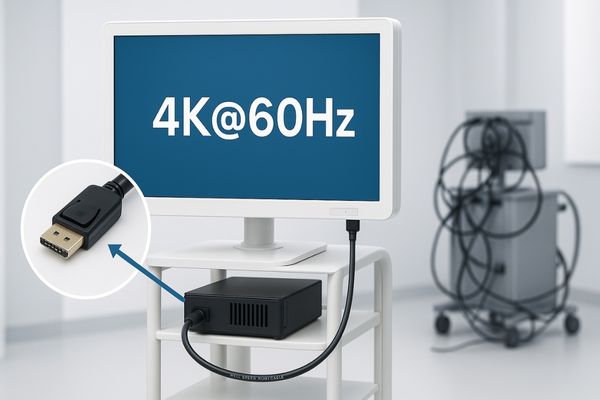
The ability to transmit a high-resolution, high-frame-rate signal10 through one cable is a significant technological achievement. A 4K (3840×2160) signal at a fluid 60 frames per second (60Hz) with standard color depth requires approximately 18 Gigabits per second (Gbps)11 of data bandwidth. In the past, achieving this required multiple cables. For example, early 4K systems sometimes used two HDMI 1.4 cables or four separate 3G-SDI cables in a "quad-link" configuration. This was cumbersome, expensive, and introduced four times the potential points of failure. Today, several modern interfaces can handle this bandwidth easily over one cable. This simplifies everything from system design and installation to daily use and maintenance. A single connection reduces cable clutter in the operating room, minimizes setup time, and lowers the chance of a connection error. It is critical, however, to use high-quality cables12 that are certified for the required bandwidth. A cheap, uncertified HDMI or DisplayPort cable may not be able to reliably carry an 18 Gbps signal, leading to flickering or a complete loss of video.
Single-Cable 4K@60Hz Solutions
| Interface | Max Distance (Typical) | Connector Type | Common Application |
|---|---|---|---|
| DisplayPort 1.2+ | 3-5 meters | Locking 20-pin | Diagnostic Workstations |
| HDMI 2.0+ | 10-15 meters | Friction-fit 19-pin | General Purpose, Endoscopy |
| 12G-SDI | 100 meters | Locking BNC | Integrated OR, Broadcast |
| USB-C (DP Alt Mode) | 1-2 meters | Reversible 24-pin | Mobile Devices, Laptops |
What are the advantages of optical fiber transmission for 4K video?
Standard copper cables are vulnerable to electronic noise, which can corrupt the video signal. This interference is a major risk, but optical fiber transmission is completely immune to it.
The main advantages of optical fiber are its complete immunity to electromagnetic interference (EMI), its ability to transmit 4K video over extremely long distances (kilometers) without signal loss, and its smaller, lighter cable profile compared to high-bandwidth copper cables.
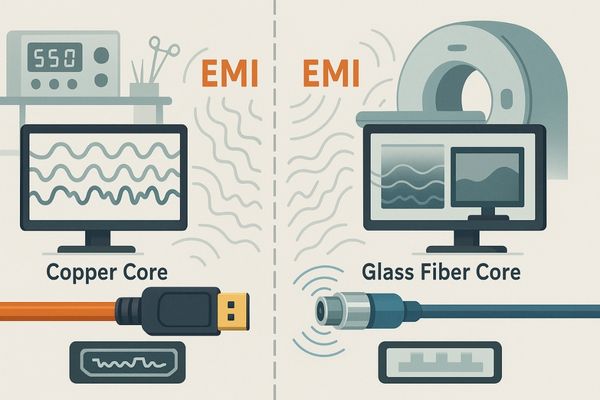
Optical fiber technology offers the ultimate performance for video transmission, especially in challenging environments. Unlike copper cables (like HDMI, DP, and SDI) that transmit data using electrical signals, fiber optic cables13 use pulses of light. This fundamental difference provides three key advantages. The first and most important in a medical setting is immunity to electromagnetic interference (EMI)14. Operating rooms are filled with equipment that generates EMI, such as electrosurgical units. This radiation can induce noise in copper cables, causing image artifacts or signal loss. Because fiber optic cables transmit light, they are completely immune to this interference, guaranteeing a perfectly clean signal. The second advantage is distance. While SDI is impressive at 100 meters, fiber can transmit a 4K signal15 for kilometers with zero degradation. This is ideal for connecting buildings on a hospital campus. Finally, fiber optic cables are significantly thinner and lighter than copper cables with equivalent bandwidth, making them easier to route through crowded conduits and cable trays.
How important is interface compatibility in hybrid OR setups?
A hybrid OR combines many different imaging devices. Incompatible connections create frustrating delays and workflow bottlenecks, but multi-interface displays ensure seamless integration for every device.
Interface compatibility is critically important in a hybrid OR. These complex environments integrate multiple video sources like C-arms, endoscopes, and ultrasound machines. A monitor with diverse inputs (DP, HDMI, SDI) ensures any device can be connected quickly, maximizing flexibility and uptime.
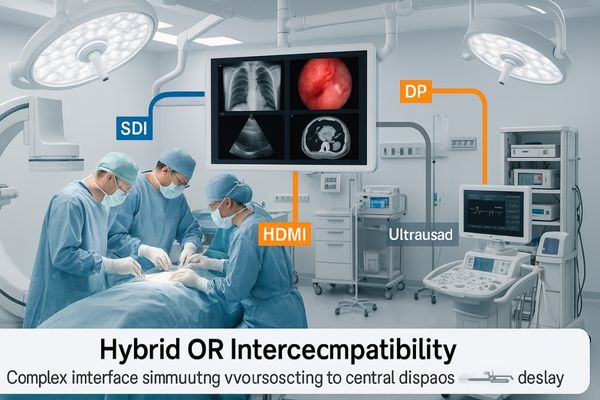
A hybrid operating room16 is a sophisticated space that combines the capabilities of a traditional surgical suite with an interventional radiology suite. This means a single procedure might involve multiple imaging modalities. For example, a surgeon might use a 4K endoscope17 (often with an HDMI or DP output) for the main procedure while simultaneously referencing live C-arm fluoroscopy images (typically with an SDI output) and reviewing a patient’s CT scan from a PACS workstation (usually with a DP output). In this scenario, the primary surgical display must be able to accept and switch between all these different signal types seamlessly. If the monitor lacks the necessary inputs, the staff must rely on external switchers and converters. These extra boxes add complexity, cost, and potential points of failure to the system. A monitor equipped with a comprehensive set of inputs, like the MS430PC, acts as a versatile hub. It provides dedicated ports for HDMI, DisplayPort, and SDI, ensuring that any piece of equipment can be connected directly. This simplifies the room’s design, streamlines workflow, and gives the surgical team the flexibility to use the best imaging tool for each stage of the procedure.
Conclusion
Selecting the right interface is not just a technical detail. It is a fundamental step toward ensuring reliable, high-quality 4K imaging for better patient care and procedural efficiency. For expert guidance on medical displays with advanced 4K connectivity, contact Reshin at martin@reshinmonitors.com.
- Understanding signal integrity is crucial for ensuring high-quality medical imaging. Explore this link to learn more about its importance. ↩
- Stay updated on the latest advancements in medical imaging technology to improve clinical outcomes and efficiency. ↩
- Discover the advantages of 4K displays in medical imaging to enhance diagnostic accuracy and patient care. ↩
- Explore the benefits of DisplayPort, especially in professional settings like radiology, to understand its superiority over HDMI. ↩
- Discover the significance of 4K at 60Hz in display technology and its impact on visual clarity and performance in professional applications. ↩
- Learn about MST and how it enhances multi-monitor setups, making it essential for efficient workflows in clinical environments. ↩
- Explore the benefits of SDI, including its reliability and long-distance capabilities, crucial for professional video applications. ↩
- Learn how 12G-SDI outperforms HDMI in maintaining signal integrity over long distances, essential for high-quality video. ↩
- Discover best practices for surgical displays to enhance clarity and reliability during critical procedures in the OR. ↩
- Exploring this resource will provide insights into the advantages and applications of high-resolution signals in modern technology. ↩
- Understanding Gbps is crucial for grasping data transmission capabilities and requirements in high-definition video technology. ↩
- This link will explain the significance of using certified high-quality cables to ensure reliable data transmission and prevent issues. ↩
- Discover the benefits of fiber optic technology, including distance and signal quality, which are essential for modern video transmission. ↩
- Understanding EMI is crucial for optimizing video transmission in sensitive environments like hospitals. Explore this link to learn more. ↩
- Learn how fiber optics enable high-quality 4K video transmission over long distances without degradation, a game-changer for video technology. ↩
- Explore the advantages of hybrid operating rooms, which enhance surgical precision and efficiency by integrating advanced imaging technologies. ↩
- Learn how 4K endoscopes enhance visualization during surgeries, leading to better outcomes and precision in complex procedures. ↩


